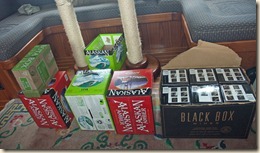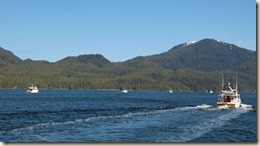In 2010, we hung around the Ketchikan area for about a month before rendezvousing with our friends Dorothy & Dave Nagle and their vessel the DavidEllis. During that time we explored a number of areas and identified some worth repeating. Specifically they were worth repeating because we were able to catch crabs.
This year we came equipped for more serious crabbing with three pots instead of only one. We stood pat with only one prawn pot since they are dropped much deeper (i.e., more line to store and handle) than crab pots. Additionally, we both bought Alaska fishing permits instead of only Marcia as we did last year. That means I can drop and retrieve pots instead of Marcia having to do it while I chauffeur her around in the dinghy.
We left shortly after 8 AM on June 12, and motored in pretty calm conditions through Clover Passage, out into Behm Canal and into Yes Bay. We made our way to the same spot as we used last year, at the head of the innermost cove. The two passages joining the outer bay to the 1st inner and the 1st inner to the 2nd (and furthest) inner are narrow but deep. Stay to the east shore and you’ll be all right.
By about a quarter to 3 pm, the anchor was down and engine off.
The day’s mileage was 40.6 bringing the cumulative distance to 720.1 miles. The anchor location is here.
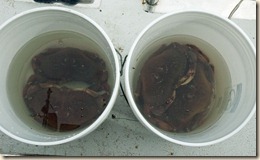 The next day, June 13, in the rain we went out and checked the pots and found 3 keepers among the 5 total crabs in the 3 pots. Most of the bait was intact so we just reset the pots with existing bait. The afternoon check came up blank so I moved the pots to new locations. We also set our prawn pot in the first/outer Yes Bay near where we saw pot floats as we entered. The depths were about 200 feet there.
The next day, June 13, in the rain we went out and checked the pots and found 3 keepers among the 5 total crabs in the 3 pots. Most of the bait was intact so we just reset the pots with existing bait. The afternoon check came up blank so I moved the pots to new locations. We also set our prawn pot in the first/outer Yes Bay near where we saw pot floats as we entered. The depths were about 200 feet there.
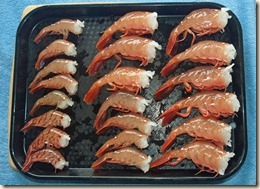 On the morning of June 14, the pot pull was as dreary as the weather with zero crabs in them. The prawn pot, though, had 20 spot prawns worth keeping. The photo right shows the now headless prawns waiting to be cooked.
On the morning of June 14, the pot pull was as dreary as the weather with zero crabs in them. The prawn pot, though, had 20 spot prawns worth keeping. The photo right shows the now headless prawns waiting to be cooked.
We start the engine shortly after 10 AM and head to location on Behm Canal we did not visit last year but with reportedly good crabbing. About 3:30 PM we are anchored in Fitzgibbon Cove. Since we pulled our dinghy behind us, we were able to get crab pots quickly after we were anchored.
The day’s mileage was 26.0 miles bringing the cumulative distance to 746.1 miles. The anchor location is here.
Expectations are high the morning of June 15 as we motor over to the first pot. Up it comes and 5 crabs are doing the Muhammad Ali rope-a-dope in the cage daring me to reach for them. With careful jabs and pot jostling to disrupt their footwork, we get them into the plastic buckets.
The next pot pull brings up 8 crabs. After culling the sole female crab and another barely legal (6-1/2 inches across the carapace in Alaska), we take one and leave the others in the pot. Alaska regulations allow only 6 in “possession” at a time. Once the crab is processed into a form able to be preserved 15 days or more, it is not in “possession” any longer. For us that means frozen and stored in the freezer.
Marcia gets busy, killing, cleaning, cooking and picking.
 |  |  | 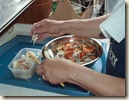 |
After the first set of six are processed and frozen, I go out and check our 3rd pot. Four more keepers there. I add two from the crabs waiting in pot number 2 and bring the “lucky” six back to Marcia (see photos above). Processing crab is a lot of work and Marcia is pretty pooped after the second set of six, so we call it a day.
The next morning, June 16, shows only the three crabs in pot number 2 that have been patiently waiting since the day before. I feel badly for one (the smallest) and toss it back. The other two return with me and, eventually, there meat goes into the freezer. Before we start the engine for our next anchorage, we decide 14 keeper crabs makes Fitzgibbon Cove worth another visit in the future.
The next destination is Fire Cove in Neets Bay. The previous two anchorages were pretty big so finding a suitable spot with plenty of swing room was not a problem. Fire Cove is more intimate and an uncharted rock that is revealed on 5 foot tides complicates things. After some fussing, we anchor in a location and fashion that both Marcia & I can sleep well with. With the freezer more full than when we started despite nearly three weeks of travelling, we put only two pots down for an overnight soak.
Today’s mileage is 33.0 bringing the cumulative total to 779.1. We are anchored here.
The next morning, June 17, we dinghy over to the pots and pull them. The first pot had five crabs, all legal. The second pot comes up with 9 crabs (actually 8 inside and one hanging on the outside of the pot). Processing six crabs was all that Marcia signed up for so we keep the six biggest and throw the others back for next year. All that “free” time gave Marcia the opportunity to make fresh bread to accompany the crab casserole she made.
On June 18, we get an “oh-dark thirty” start to catch favorable currents out of Behm Canal and up Clarence Strait. It was reminiscent of our earlier trip north because we covered over 80 miles. Fortunately conditions were good and the hardest part was staying awake from the early start.
The trip through Kashevarof Passage was lovely. The water was glassy. The Blashke Islands to the right of the passage look like a great place for kayakers to explore and camp. For a large power boat, they would be a nightmare of hidden rocks and tricky route-finding. We anchor a short distance beyond in Exchange Cove. The entrance and the anchor field was dotted with commercial crab pots which required some effort on our part to avoid. Shortly after 4 PM we are anchored.
Today’s mileage is 84.1 bringing the cumulative total to 863.2. We are anchored here.
Our previous plan had been to continue counter clock wise around Prince of Wales Island to Hole-in-the-Wall anchorage. Since we will probably head south via that route, we decided to forgo that extra leg and head over to Wrangell.
On June 19, we start the engine at 8:30 AM to catch the flood east up Sumner Strait towards Wrangell. The trip there was pretty benign and by 2:30 PM we are tied up to Reliance Dock in Wrangell.
Dinner tonight is with our friends Dorothy & Dave Nagle who are with their boat in Wrangell where it has been since February having work done on it.
Today’s mileage is 36.9 with the cumulative mileage at 900.1. We are moored here.


